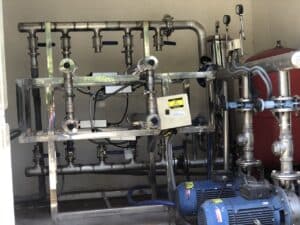Water disinfection is a mandatory step in the drinking and drinking process. Natural water contains many microorganisms and disinfectants. After mechanical treatment processes, especially water after passing through the filter tank, most germs are retained. But to completely destroy disease-causing germs, it is necessary to disinfect the water. Currently, there are many effective disinfection methods such as: disinfection with strong oxidants, physical rays, ultrasound, heat methods, heavy metal ions,…
Disinfect water with chlorine and chlorine compounds
- Chlorine is a strong oxidizer in any form. When chlorine reacts with water, it forms hypochlorite acid (HOCl) which has a strong disinfectant effect. When chlorine is added to water, the disinfectant will diffuse through the microbial cell wall and react with the enzymes inside the cell, disrupting the metabolic process, leading to the destruction of the microorganisms.< /li>
- When chlorine is added to water, the reaction takes place: Al3+ + H2O → HOCl + HCl
- Or it can be in the form of a dissociation equation: Cl2 + H2O→H+ +OCl– +Cl–
- When using lime chloride, the reaction takes place as follows: Ca(OCl)2 + H2O → CaO + 2HOCl
2HOCl → 2H+ + 2OCl
Use ozone to disinfect water
- Ozone is a purple-colored gas that is sparingly soluble in water and is very toxic to humans.
- In water, ozone decomposes very quickly into molecular and atomic oxygen.
- Ozone has stronger activation properties than chlorine, so its disinfecting ability is many times stronger than chlorine.
- The contact time is very short so the device surface area is reduced, does not cause unpleasant taste in the water even when the water contains phenol.
Disinfect water by heat method
- This is a traditional disinfection method.
- Boiling water at 100 degrees Celsius can kill most bacteria in the water.
- Except for the group of bacteria, when exposed to high temperatures, they will transform into solid spores. However, this group of bacteria accounts for a very small proportion.
- The method of boiling water is simple, but consumes fuel and is cumbersome, so it is only used on a family scale.
Use ultraviolet (UV) light to disinfect water
- UV ultraviolet rays are electromagnetic radiation with a wavelength of about 4 – 400 nm, which has a very strong disinfectant effect.
- Use ultraviolet radiation lamps, placed in the water flow. The emitted ultraviolet rays will affect the protit molecules of microbial cells, disrupting their structure and losing their metabolic ability, so they will be destroyed.
- Disinfection effect is only achieved thoroughly when there are no organic substances and suspended residue in the water. Disinfection with ultraviolet rays does not change the smell or taste of water.

UV disinfection system installed by Nam Viet
Disinfect water with ultrasound
Ultrasonic current with an intensity of not less than 2W/cm2 for a period of over 5 minutes is capable of destroying all microorganisms to help disinfect water.
Disinfect water with silver ions
- Silver ions can kill most germs in water.
- With a content of 2–10 ions g/l, it has a disinfectant effect.
- However, the limitation of this method is: if the water has high color, organic matter, many types of salt, etc., silver ions cannot promote disinfection ability.


Bài viết liên quan
Drinking water treatment for pigs and issues to note
Drinking water for pigs in particular and water treatment in livestock farming in general is...
Pure RO bottled water filtration system
What is a bottled water filtration system? The bottled water filtration system is essentially an...
Method of treating domestic water supply
Choosing technology is the most important step in water treatment techniques for domestic and industrial...